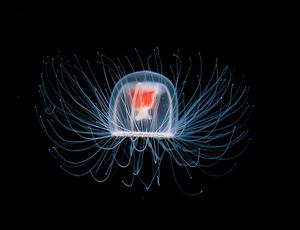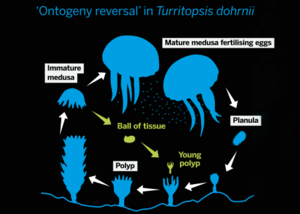Turritopsis dohrnii: Difference between revisions
Fitzgerald3 (talk | contribs) |
Fitzgerald3 (talk | contribs) |
||
| Line 6: | Line 6: | ||
<br><br> | <br><br> | ||
Although a rare ability, reverse development has been reported in several other Cnidaria species. Some of these include <i>Laodicea undulata</i>,<ref name=DeVito> De Vito D, Piraino S, Schmich J, Bouillon J, Boero F. Evidence of reverse development in Leptomedusae (Cnidaria, Hydrozoa): the case of Laodicea undulata (Forbes and Goodsir 1851). Marine Biology. 2006 May 1;149(2):339-46. Available from: https://link.springer.com/article/10.1007%2Fs00227-005-0182-3</ref> <i>Aurelia</i> sp.,<ref name=He> He J, Zheng L, Zhang W, Lin Y. Life cycle reversal in Aurelia sp. 1 (Cnidaria, Scyphozoa). PloS one. 2015 Dec 21;10(12):e0145314. Available from: https://www.ncbi.nlm.nih.gov/pmc/articles/PMC4687044/</ref> <i>Hydractinia carnea</i>,<ref name=Schmich/> <i>Podocoryne carnea</i>, <i>Eleutheria dichotoma</i>, <i>Cladonema</i> sp. and <i>Cladonema uchidai</i>, and <i>Perarella schneideri</i>.<ref name=Piraino1996/> However, these species can only undergo reverse development during the early stages of medusa bulb development. What makes <i>Turritopsis dohrnii</i> unique is its ability to revert after sexual maturation.<ref name=Piraino1996/> | Although a rare ability, reverse development has been reported in several other Cnidaria species. Some of these include <i>Laodicea undulata</i>,<ref name=DeVito> De Vito D, Piraino S, Schmich J, Bouillon J, Boero F. Evidence of reverse development in Leptomedusae (Cnidaria, Hydrozoa): the case of Laodicea undulata (Forbes and Goodsir 1851). Marine Biology. 2006 May 1;149(2):339-46. Available from: https://link.springer.com/article/10.1007%2Fs00227-005-0182-3</ref> <i>Aurelia</i> sp.,<ref name=He> He J, Zheng L, Zhang W, Lin Y. Life cycle reversal in Aurelia sp. 1 (Cnidaria, Scyphozoa). PloS one. 2015 Dec 21;10(12):e0145314. Available from: https://www.ncbi.nlm.nih.gov/pmc/articles/PMC4687044/</ref> <i>Hydractinia carnea</i>,<ref name=Schmich/> <i>Podocoryne carnea</i>, <i>Eleutheria dichotoma</i>, <i>Cladonema</i> sp. and <i>Cladonema uchidai</i>, and <i>Perarella schneideri</i>.<ref name=Piraino1996/> However, these species can only undergo reverse development during the early stages of medusa bulb development. What makes <i>Turritopsis dohrnii</i> unique is its ability to revert after sexual maturation.<ref name=Piraino1996/> | ||
<br><br> | |||
The immortal nature of <i> Turritopsis dohrnii</i> makes it of interest for research in aging, cancer, and regenerative medicine. | |||
Revision as of 07:22, 8 December 2020
Introduction

Turritopsis dohrnii (previously classified as Turritopsis nutricula),[1] commonly known as the immortal jellyfish or the Benjamin Button jellyfish,[2] is a small species of jellyfish known for its unique ability to revert back to an earlier life stage through transdifferentiation.[3][4] This ontogeny reversal renders the organism virtually immortal as this process has the potential to repeat itself indefinitely, although organismal death does still occur in its natural environment.[5] Reverse development can be triggered by a variety of stressors including starvation, changes in temperature or salinity, physical damage, or age-related deterioration.[4]
Although a rare ability, reverse development has been reported in several other Cnidaria species. Some of these include Laodicea undulata,[6] Aurelia sp.,[7] Hydractinia carnea,[3] Podocoryne carnea, Eleutheria dichotoma, Cladonema sp. and Cladonema uchidai, and Perarella schneideri.[5] However, these species can only undergo reverse development during the early stages of medusa bulb development. What makes Turritopsis dohrnii unique is its ability to revert after sexual maturation.[5]
The immortal nature of Turritopsis dohrnii makes it of interest for research in aging, cancer, and regenerative medicine.
Life Cycle

Include some current research, with at least one image.
Genetics
Microbial Relationships
Include some current research, with a second image.
<be>
Medical Potential
Conclusion
Overall text length should be at least 1,000 words (before counting references), with at least 2 images. Include at least 5 references under Reference section.
References
- ↑ Schuchert P. Revision of the European athecate hydroids and their medusae (Hydrozoa, Cnidaria): families Oceanidae and Pachycordylidae. Revue suisse de Zoologie. 2004 Jun 1;111(2):315-70. Available from: https://www.semanticscholar.org/paper/Revision-of-the-European-athecate-hydroids-and-and-Schuchert/e3d3dce80157e5ee98ecbe0bbe7d35eb36cbe82b?p2df
- ↑ Than K. "Immortal" Jellyfish Swarm World's Oceans [Internet]. National Geographic. 2009. Available from: https://www.nationalgeographic.com/animals/2009/01/immortal-jellyfish-swarm-oceans-animals/
- ↑ 3.0 3.1 Schmich J, Kraus Y, De Vito D, Graziussi D, Boero F, Piraino S. Induction of reverse development in two marine Hydrozoans. Int J Dev Biol. 2007 Feb 1;51:45–56. Available from: https://www.researchgate.net/publication/6617831_Induction_of_reverse_development_in_two_marine_Hydrozoans
- ↑ 4.0 4.1 Piraino S, De Vito D, Schmich J, Bouillon J, Boero F. Reverse development in Cnidaria. Canadian Journal of Zoology. 2004 Nov 1;82(11):1748-54. Available from: https://www.researchgate.net/profile/Stefano_Piraino/publication/249542511_Reverse_development_in_Cnidaria/links/004635220749d81dc3000000/Reverse-development-in-Cnidaria.pdf
- ↑ 5.0 5.1 5.2 Piraino S, Boero F, Aeschbach B, Schmid V. Reversing the life cycle: medusae transforming into polyps and cell transdifferentiation in Turritopsis nutricula (Cnidaria, Hydrozoa). The Biological Bulletin. 1996 Jun 1;190(3):302-12. Available from: https://www.journals.uchicago.edu/doi/pdfplus/10.2307/1543022?casa_token=VCv_136r__UAAAAA%3ARVFGUXoAfbOsfuX2x2l8RiTdYNa4mgvDPrnVFQEo5KUbmRat544_LD8iRbOzKJjDNuSi38-gjDo7&
- ↑ De Vito D, Piraino S, Schmich J, Bouillon J, Boero F. Evidence of reverse development in Leptomedusae (Cnidaria, Hydrozoa): the case of Laodicea undulata (Forbes and Goodsir 1851). Marine Biology. 2006 May 1;149(2):339-46. Available from: https://link.springer.com/article/10.1007%2Fs00227-005-0182-3
- ↑ He J, Zheng L, Zhang W, Lin Y. Life cycle reversal in Aurelia sp. 1 (Cnidaria, Scyphozoa). PloS one. 2015 Dec 21;10(12):e0145314. Available from: https://www.ncbi.nlm.nih.gov/pmc/articles/PMC4687044/
Edited by Bailey Fitzgerald, student of Joan Slonczewski for BIOL 116 Information in Living Systems, 2020, Kenyon College.
